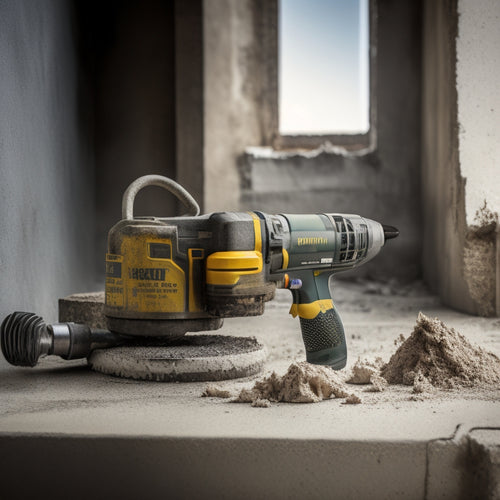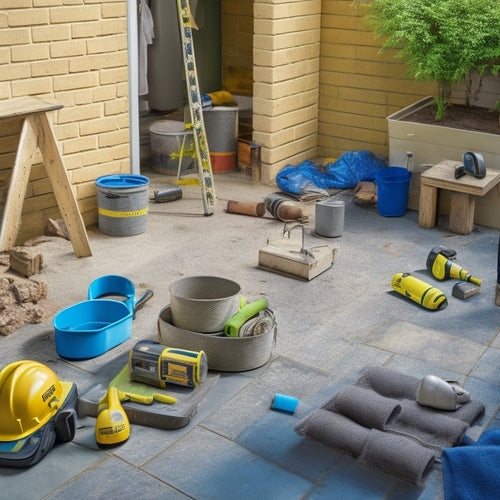
3 Best Plastering Tools for Small Renovations
Share
You'll need the right tools to achieve a professional-looking finish in your small renovation project, and that starts with a reliable trowel, efficient sanding tools, and a well-equipped mixing bucket. A high-quality trowel is vital for applying and leveling plaster, while sanding tools like sandpaper and a sanding block help you achieve a smooth finish. Finally, a mixing bucket with a comfortable mixing paddle and non-slip base makes the mixing process more effective. With these three essential tools, you'll be well on your way to a successful renovation - and there's even more to discover to guarantee your project turns out perfectly.
Key Takeaways
• A high-quality trowel is essential for applying and leveling plaster, with stainless steel ideal for thick coats and flexible trowels for curved surfaces.
• Sandpaper in various grits is necessary for smoothing and polishing, with a sanding block and dusting brush aiding in the process.
• A mixing paddle with a comfortable grip and non-slip base improves mixing efficiency and stability, while a mixing drill with variable speed control accommodates different materials.
• Regular cleaning and maintenance of tools, such as trowels and sanding blocks, prevent plaster from drying on them and ensure a smooth finish.
• Upgrading bucket accessories, like a bucket lid or cover, helps keep the mix clean and contained, streamlining the mixing process and reducing mess.
Essential Trowel for Smooth Finish
You'll need a high-quality trowel to achieve a smooth finish, as it's the most important tool for applying and leveling plaster. With so many trowel types available, it's vital to choose the right one for your project. You'll want to take into account the size, material, and shape of the trowel, as well as its handle type and grip.
For example, a stainless steel trowel is ideal for applying thick coats of plaster, while a flexible trowel is better suited for curved surfaces. Proper trowel maintenance is also significant for achieving a smooth finish. Make sure to clean your trowel regularly to prevent plaster from drying on the surface.
A wire brush or sandpaper can be used to remove any dried-on plaster. You should also apply a thin layer of oil to the trowel's surface to prevent rust and corrosion. By choosing the right trowel and maintaining it properly, you'll be able to achieve a smooth, professional-looking finish that will elevate your renovation project.
Perfect Finishing With Sanding Tools
With a smooth base coat in place, it's time to bring out the sanding tools to perfect the finish. You've got the foundation laid, now it's time to refine it. Sanding is an art that requires finesse, patience, and the right tools. You'll want to master various sanding techniques to achieve a smooth, even finish.
Here are the essential sanding tools you'll need:
| Tool | Description | Purpose |
|---|---|---|
| Sandpaper (various grits) | Coarse to fine grit papers | Smoothening, polishing |
| Sanding block | Flat, rectangular block | Preventing unevenness |
| Dusting brush | Soft-bristled brush | Dust control, cleaning |
When sanding, remember to work progressively from coarse to fine grits, and always sand in a circular motion. Don't forget to dust regularly to prevent scratches and maintain a smooth finish. With these tools and techniques, you'll be able to achieve a professional-looking finish that will make your renovation stand out. By mastering sanding, you'll be able to tackle even the most demanding projects with confidence.
Efficient Mixing With Bucket Accessories
Your bucket is now a mixing powerhouse, thanks to the right accessories that streamline the process and eliminate mess. With the correct tools, you'll master efficient mixing techniques and get the job done faster.
A mixing paddle with a comfortable grip and sturdy design is a must-have. It allows for smooth, consistent mixing and reduces fatigue. A bucket with a non-slip base and graduated measurements is another essential. It provides bucket advantages like stability and accuracy, ensuring you get the right mix every time.
Don't forget a mixing drill with variable speed control. It gives you the power to tackle tough mixes and adjust to different materials. A bucket lid or cover is also a game-changer, keeping your mix clean and contained.
With these accessories, you'll be able to mix and match different materials quickly and easily. Say goodbye to messy clean-ups and hello to professional results. By upgrading your bucket with these essential accessories, you'll be well on your way to achieving perfect plastering results for your small renovation projects.
Frequently Asked Questions
How Do I Prevent Plaster From Drying Too Quickly on the Wall?
When you're working with plaster, you need to control the temperature and humidity to prevent it from drying too quickly on the wall.
You're aiming for a sweet spot between 60-70°F (15-21°C) and 50-60% humidity.
If it's too hot or dry, the plaster will set too fast, leading to cracks and uneven finishes.
Keep an eye on the conditions and adjust as needed to guarantee a smooth, long-lasting result.
Can I Use a Drill to Mix Plaster, or Is It a Bad Idea?
When in doubt, don't - and in this case, don't use a drill to mix plaster.
You'll end up with a mixture that's too dense and chunky.
Instead, opt for a mixing paddle or whisk attached to a slower drill type, like a cordless or handheld, to maintain control over your mixing techniques.
This guarantees a smooth, even consistency that's perfect for your renovation project.
What Safety Gear Do I Need to Wear When Working With Plaster?
When working with plaster, you're dealing with messy, airborne particles that can harm your eyes and lungs.
Protect yourself by wearing essential safety gear. You'll need safety goggles to shield your eyes from flying debris and dust masks to filter out harmful particles.
Don't skip these vital steps - you only get one pair of eyes and lungs, so take care of them!
How Do I Remove Dried Plaster From My Tools and Equipment?
You're stuck in the quagmire of dried plaster, aren't you? Like a knight trapped in the mire, your tools are helpless without your rescue.
Break free with these plaster removal techniques: soak in warm water, scrape off excess with a putty knife, and use a wire brush for stubborn bits.
Proper tool maintenance tips: clean and dry tools immediately, and apply a rust-inhibiting coating to prevent future stickiness.
Can I Reuse Leftover Plaster From a Previous Project?
You're wondering if you can reuse leftover plaster from a previous project. Here's the deal: it's possible, but only if you've stored it properly.
You should've kept it in an airtight container, away from moisture and contaminants. If you've done that, you can reuse it for small repairs or as a bonding coat.
Just mix it with some fresh plaster to guarantee it's still workable.
Don't waste it - get creative with leftover plaster uses and make the most of your storage tips!
Conclusion
You've got the renovation bug and are ready to tackle that small project. With the right plastering tools, you'll be smooth sailing to a professional-looking finish.
Remember, a good trowel is the unsung hero of plastering, providing a silky smooth surface.
Sanding tools are the perfect sidekick, ensuring a flawless finish.
And, let's not forget the humble bucket accessories, the behind-the-scenes champions of efficient mixing.
With these three essential tools, you'll be plastering like a pro in no time, and your renovation will be the icing on the cake.
Related Posts
-

Top Drill for Concrete Wall Renovation
When choosing the top drill for your concrete wall renovation, you'll want to prioritize key features like drill powe...
-

7 Patio Safety Tips for DIY Renovation Projects
As you begin your DIY patio renovation project, prioritize safety by evaluating the worksite for tripping hazards and...
-

10 Best Power Tools to Buy for Home Renovation
To tackle your home renovation project efficiently, you'll need the right power tools for the job. A cordless drill f...


